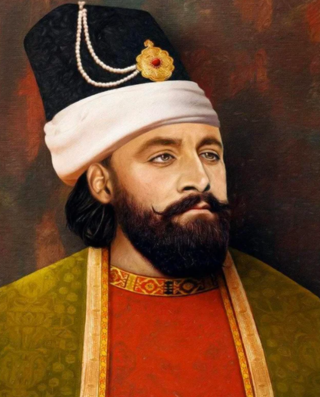Related Research Articles

Shaki is a city in northwestern Azerbaijan, surrounded by the district of the same name. It is located in the southern part of the Greater Caucasus mountain range, 240 km (150 mi) from Baku. As of 2020, it has a population of 68,400. The center of the city and the Palace of Shaki Khans were inscribed in the UNESCO World Heritage List in 2019 because of their unique architecture and history as an important trading center along the Silk Road.

The Karabakh Khanate was a khanate under Iranian and later Russian suzerainty, which controlled the historical region of Karabakh, now divided between modern-day Armenia and Azerbaijan. In terms of structure, the Karabakh Khanate was a miniature version of Iranian kingship. The administrative and literary language in Karabakh until the end of the 19th century was Persian, with Arabic being used only for religious studies, despite the fact that most of the Muslims in the region spoke a Turkic dialect.

The Ganja Khanate was a khanate under Iranian suzerainty, which controlled the town of Ganja and its surroundings, now located in present-day Azerbaijan.

The Shaki Khanate was a khanate under Iranian and later Russian suzerainty, which controlled the town of Shaki and its surroundings, now located in present-day Azerbaijan.

Shirvan Khanate was a Caucasian khanate under Iranian suzerainty, which controlled the Shirvan region from 1761 to 1820.
Ibrahim Khalil Khan Javanshir was the second khan of the Karabakh Khanate from the Javanshir family. He was the son and successor of Panah-Ali khan Javanshir.

Panah Ali Khan Javanshir was the founder and first ruler of the Karabakh Khanate under Persian suzerainty.

The Palace of Shaki Khans in Shaki, Azerbaijan, was a summer residence for the Shaki khans. It was built in 1797 by Muhammad Husayn Khan Mushtaq. The palace was intended to house the khans who were in charge of controlling Shaki, as viceroys of the ruling Zand and later Qajar Persian dynasties around 1750 until the time when these territories were annexed by the Russian Empire per the treaty of Gulistan in 1813 after the Russo-Persian War (1804–1813).
Haji Chalabi Khan, was a statesman, warlord, ruler and founder of Shaki Khanate.
Shahverdi Khan Ziyadoghlu was the beylerbey of Karabakh from 1740 to 1743 and first khan of Ganja from 1747 to 1760. He was from the Ziyadoglu branch of the Qajar clan who ruled the Beylerbeylik of Karabakh as hereditary governors.
The Khoy Khanate, also known as the Principality of Donboli, was a hereditary Kurdish khanate around Khoy and Salmas in Iran ruled by the Donboli tribe from 1210 until 1799. The khanate has been described as the most powerful khanate in the region during the second half of the 18th century. The official religion of this principality was originally Yezidism, until some rulers eventually converted to Islam. The principality has its origins under the Ayyubid dynasty and was ultimately dissolved in 1799 by Abbas Mirza. During this period, the status of principality oscillated between autonomous and independent.
Mirza Muhammad Khan I was the founding Khan of the Baku Khanate. He was a descendant of the Iranian garrison commander of Baku of 1723.
Agha Kishi Beg was the khan of the Shaki Khanate from 1755 to 1759.
Muhammad Husayn Khan Mushtaq, was the third khan of Shaki. He was described as a courageous but ruthless man by Abbasgulu agha Bakikhanov.

Shaki Khan's Mosque, previously First Khan Mosque is an 18th-century Azerbaijani mosque located in the city of Shaki.
Haji Khan or Haji Abdulaziz Khan was the fourth khan of Shaki. He was described as a brave and courageous, but extremely ruthless man by Azerbaijani historian Abbasgulu Bakikhanov.
Muhammad Hasan Khan was the fifth khan of Shaki.
Salim Khan was the sixth khan of Shaki. He was described as kind and joyful, but unmerciful man by Abbasgulu Bakikhanov.
Arash Sultanate was a feudal fiefdom that existed between 1747-1795 in Transcaucasus. It comprised modern Aghdash, Yevlakh and Mingachevir raion of Azerbaijan.
Karim agha Shakikhanov was a poet and historian who wrote in Azerbaijani and Persian.
References
- ↑ Dorn, Boris Andreevich (1858). Auszüge aus Muhammedanischen Schriftstellern: betreffend die Geschichte und Geographie der südlichen Küstenländer des Kaspischen Meeres : nebst einer kurzen Geschichte der Chane von Scheki (in German). St. Peterburg: Eggers. p. 12. OCLC 28162672.
- ↑ Mumtaz, Salman (1929). "Criticism and comments on "Brief History of Shaki Khans"". Maarif İşçisi [Enlightenment Worker] (in Azerbaijani). 2: 85–90.
- ↑ History of Shaki in Sources. Tahirzadä, Ädalät., Azärbaycan Milli Elmlär Akademiyası. Şäki Regional Elmi Märkäzi. Bakı: Master. 2005. p. 17. ISBN 0976995409. OCLC 64428641.
{{cite book}}: CS1 maint: others (link) - ↑ Seddon, Charles (1931). A Chronicle of the Early Safawis, vol. I. Baroda : Oriental Institute. pp. 180–181. OCLC 977858591.
- ↑ "ЭСБЕ/Шекинское ханство — Викитека". ru.wikisource.org. Retrieved 2019-07-01.
- ↑ Haji Seyyid, Abdulhamid. "The pedigree of Sheki khans". www.vostlit.info (in Russian). Retrieved 2019-07-01.
- ↑ Petrushevsky, Ilya (1949). Essays on the history of feudal relations in Azerbaijan and Armenia in the sixteenth and early nineteenth centuries. p. 72.
- ↑ "Шекинский Мамед Эмин Ахмед оглы | Баку | Энциклопедия | Люди". www.baku.ru. Retrieved 2021-05-22.